A few general comments before my hole-by-hole analysis, which this time will feature larger and clearer photos. (Thanks again to those who have posted reviews before me; I relied on them heavily in preparing to play both courses at Streamsong.) One thing I forgot to mention in my review of the Red course is that the greens on both courses at Streamsong are among the fastest and truest I have ever putted. The turf in general at Streamsong is firm and fast (not quite links firm, as you do leave ball marks on the greens) and goes a long way to making the courses what they are. Maintenance at both courses is superb.
As for the Blue course, it coheres better than the Red course. It has fewer standout individual holes, but better stretches of holes—1-2, 4-7, 9-12, and 14-18 each offer the type of cohesive experience that makes the game so enjoyable to play. The overall experience on the Blue is therefore better and more calming—which, in turn, led me to shoot much better scores, even though, in hindsight, Blue offers up plenty of difficulty. I loved the proximity of tees to greens (with only a few exceptions—7-8, 12-13, and, possibly, 13-14—tees are either immediately next to or a very short walk from greens). Red might have more the dramatic property, but I preferred the more gentle, nuanced terrain of the Blue, which also offers up better, and more frequent, views of Streamsong’s scale and uniqueness. I felt at times as though I was enjoying a late-summer, early evening round in Long Island—i.e., heaven. To me at least, no greater compliment can be paid to a golf course.
Streamsong Blue (Doak)Front NineThe front nine on the Blue course starts majestically, even if out of character. A tee placed high on a dune (it’s leave-your-bag-at-the-base high, and rumor has it, although I never experienced it, that the starter will often drive players to the top) affords stunning views of almost the entire Streamsong property. Views to the left of the tee reveal the first, second, fifth, sixth, and seventh holes on the Red course in all their phosphate-based glory. But the best view is the straightaway view of the hole you’re playing, the first on the Blue. It’s an infinity-type view, as you can see beyond the first green to the second hole and the holes that flank it (principally, the seventeenth to the left). The view, together with the voice of Colin, our Scottish starter who claimed to be good friends with Gil Hanse, allowed me to hit my three best tee balls of the week—perfect three-woods to the left-center of the fairway leaving me no more than 75 yards for my approach shot. In hindsight, I might have hit iron off the tee, as those short wedge shots weren't the easiest to judge. The green is to beyond the dip in terrain on the left of the fairway (interestingly, there is a similar dip in terrain to the right of the fairway, as you'll see in the pictures), so tee shots to the center or left side of the fairway are best. Tee shots to the right side of the fairway will produce blind approaches over a hillock that guards the right side of the green. A great opener and, owing to the approach, not as easy as its short length would suggest.
Streamsong Blue, Hole 1 (tee)
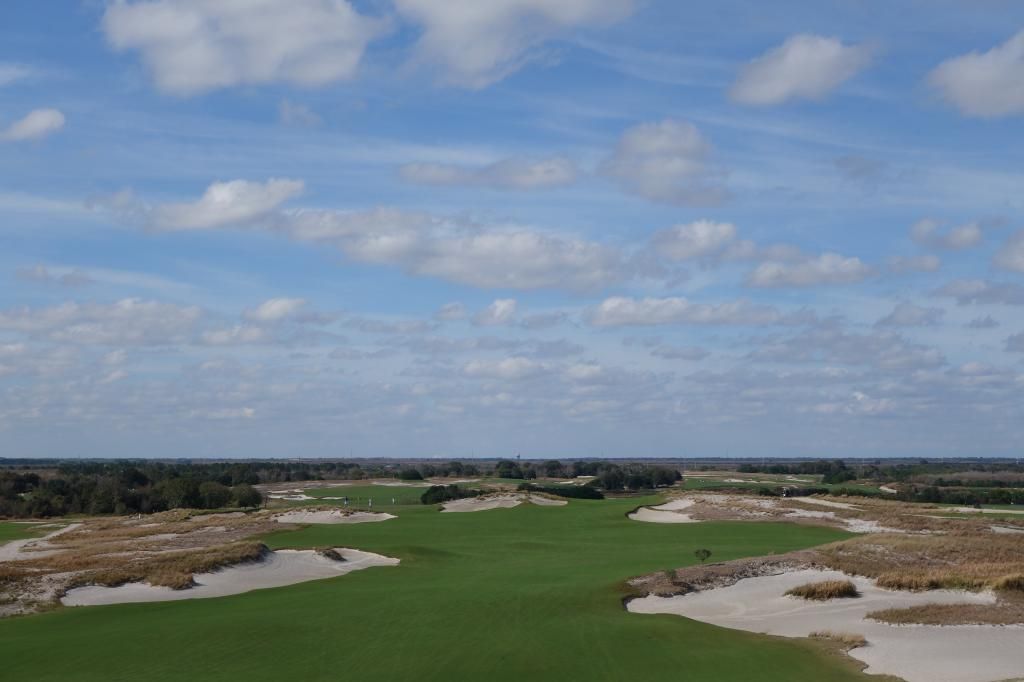
Streamsong Blue, Hole 1 (fairway; the green is NOT beyond the opening in the distance)
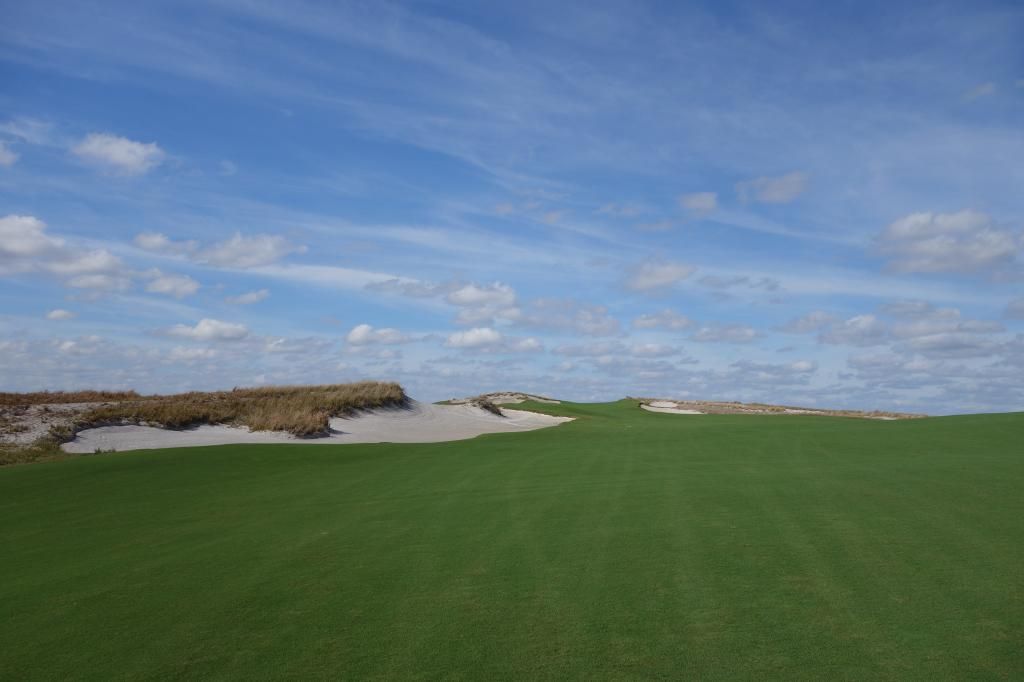
Streamsong Blue, Hole 1 (fairway; the green is beyond the dip on the left, not the similar dip on the right)
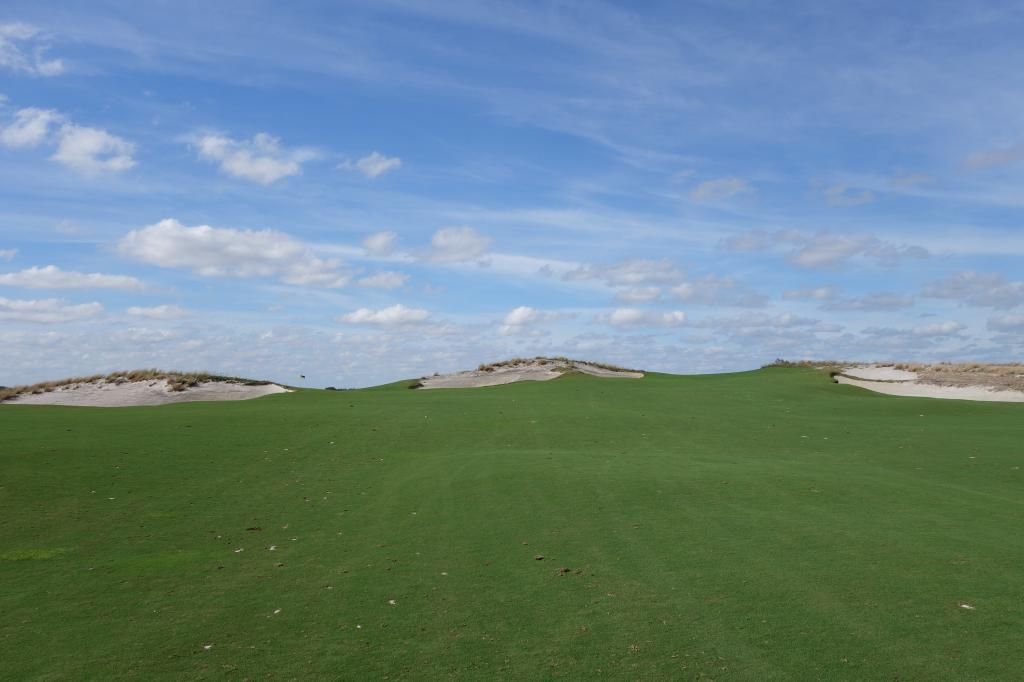
I’d compare the gradual, sweeping, and narrowing descent of the second fairway to the fifth fairway at New South Wales—with the climb to the first green at Streamsong Blue substituting for the climb to the apex of the fifth fairway at NSW. Obviously, the topography at the end of the descent is vastly different on both courses, but the effect is similar. Together with the gradual uphill climb on the first hole, the gradual descent at the second brought a calm over me and reminded me of my best—and happiest—experiences playing golf.
Streamsong Blue, Hole 2 (tee)

New South Wales, Hole 5 (fairway)
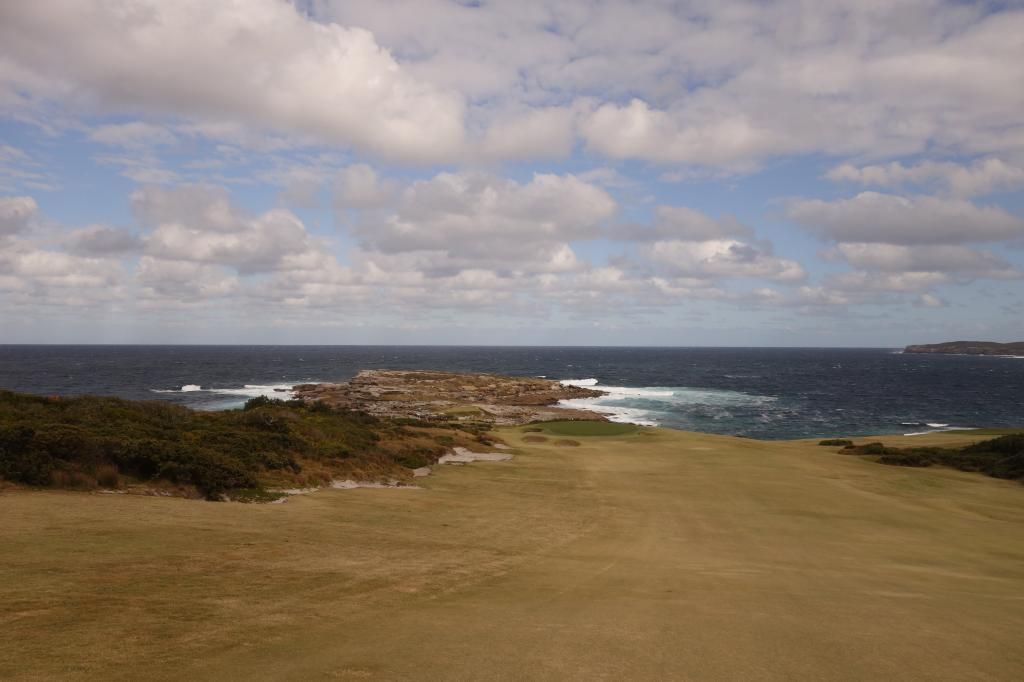
The hole itself is deceptively difficult. Although the drive doesn't pose much of a problem, the lay up does. The fairway in the layup zone remains plenty wide, but the gradual narrowing of the hole, together with the visually distracting hazards on both sides (junk to the right of the fairway, a long mound protruding from the left into the fairway) make the golfer feel like he has to be more precise than he actually does. The green is relatively flat for the Blue course, but, unlike many of the other greens, it's reachable only through the air.
Streamsong Blue, Hole 2 (fairway, including protruding mound from left)
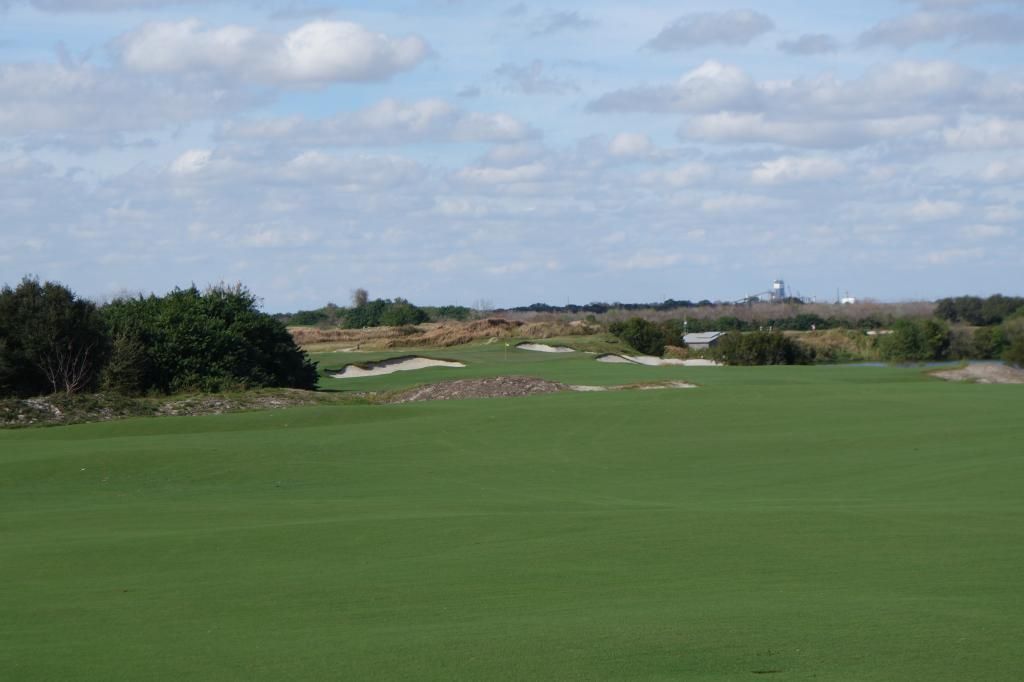
Streamsong Blue, Hole 2 (green)
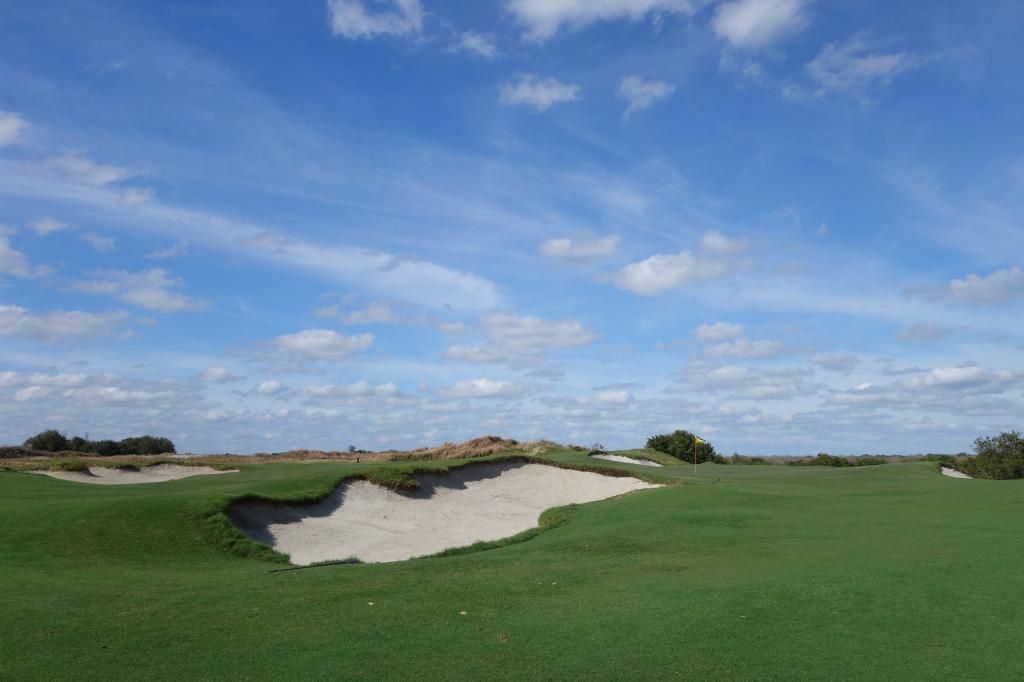
Streamsong Blue, Hole 2 (green, looking back up the fairway)

The third hole was my least favorite on the front nine. A Cape-style tee shot, with water running down the entire left side of the hole, is not as difficult as most Capes, as the carry is minimal and the fairway begins a ways away from the hazard line. But, still, the more you cut off, the shorter your approach (although even if you fan it right, you have no more than a six- or seven-iron in). The green is relatively benign, sloping from back to front, but visually appealing—as you see only sky above it as you walk from the fairway (although I wouldn't quite call it an infinity green—and not just because I know Tom hates them). A dastardly set of bunkers left saves (at least some) pulls from the water, and a long slope right propels weak fades farther from the hole.
Streamsong Blue, Hole 3 (green)
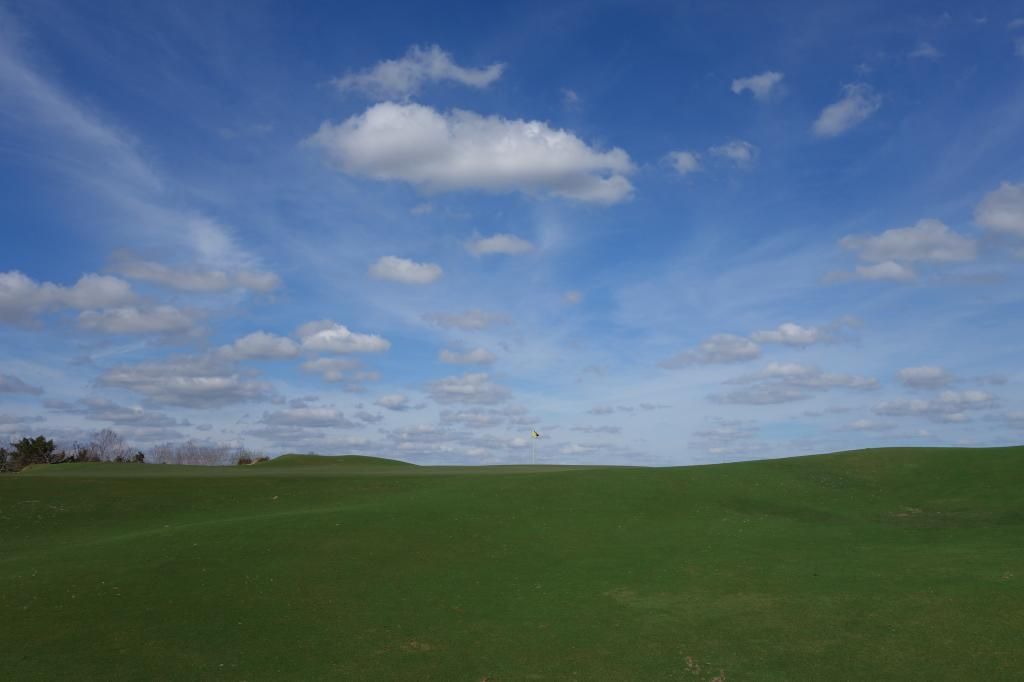
The stretch from four to seven is all-world, even if seven, like the tee on one, is out of character for the course. Four is probably the best single hole on the Blue course. The tee shot is both visually and strategically brilliant. A large bunker/waste area at once frames and cuts into the left side of the fairway, which stretches some 50 yards to the right. But the inclination is to flirt with the bunker/waste area on the left, as the flag sitting on top of a ridge in the distance seems to suggest a shorter and better-angled approach from the left side of the fairway.
Streamsong Blue, Hole 4 (tee, early afternoon)
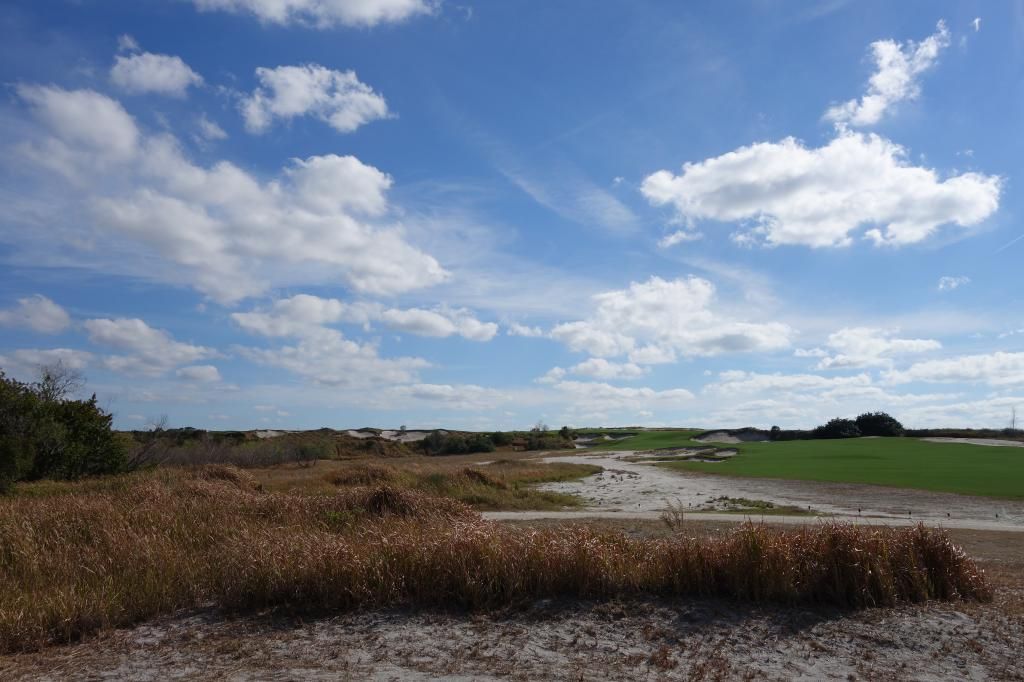
Streamsong Blue, Hole 4 (tee, early morning)

The opposite is true. From the right side of the fairway, the approach is easier, as the green runs diagonally from front right to back left. The approach from the right side of the fairway therefore gives the golfer more green to work with—even if, from right or left, only the flag is visible from the fairway. As I stood over my approach shot in each of the three rounds I played on Blue, I kept having flashbacks to Tom’s bunkering at the fourth at Barnbougle Dunes. If he responds to this post and says the latter in no way inspired his bunkering at the fourth at Streamsong Blue, I’d be genuinely shocked. The only difference is what lies beyond the bunkering. At the fourth at Barnbougle Dunes, the green is more interesting than at the fourth at Streamsong Blue, where the green is perhaps the flattest and least-defined on the course. Except for at the front of the green, there are runoff areas on all sides—but those runoffs are flat extensions of the putting surface, offering relatively straightforward recovery shots (or putts). Not so at the fourth at Barnbougle Dunes. That probably makes sense, as the fourth at Streamsong Blue is a longer hole with a longer approach shot (after three fairway-finding three-woods of the tee, I hit seven iron the first round, gap wedge the second round, and six iron the third round, when the morning dew and heavy air made everything play a bit longer).
Streamsong Blue, Hole 4 (approach)
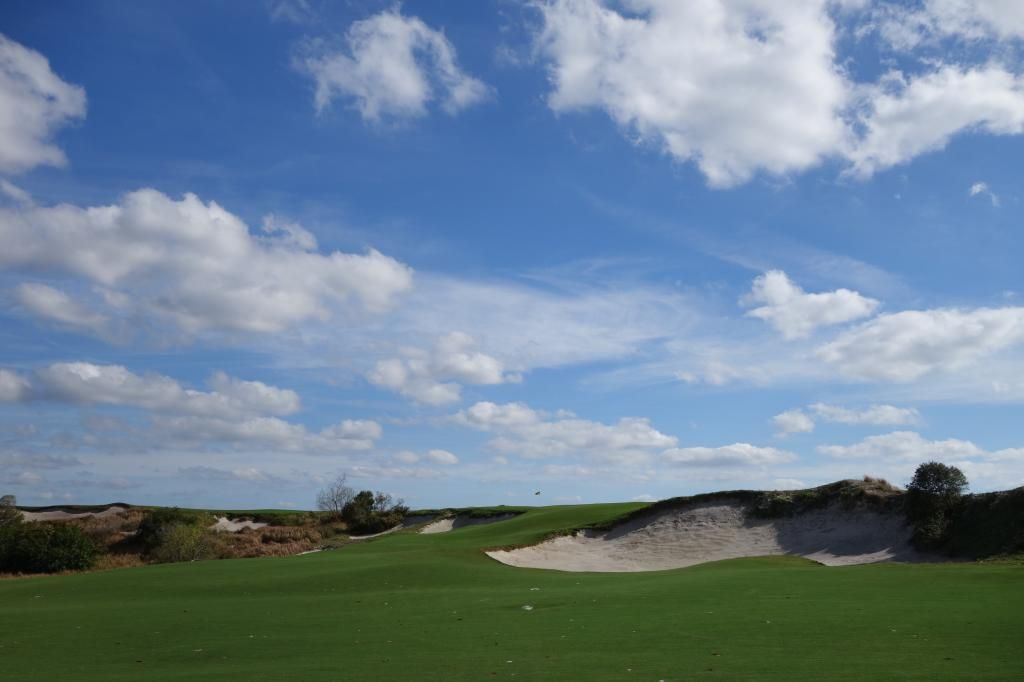
Barnbougle Dunes, Hole 4 (approach)
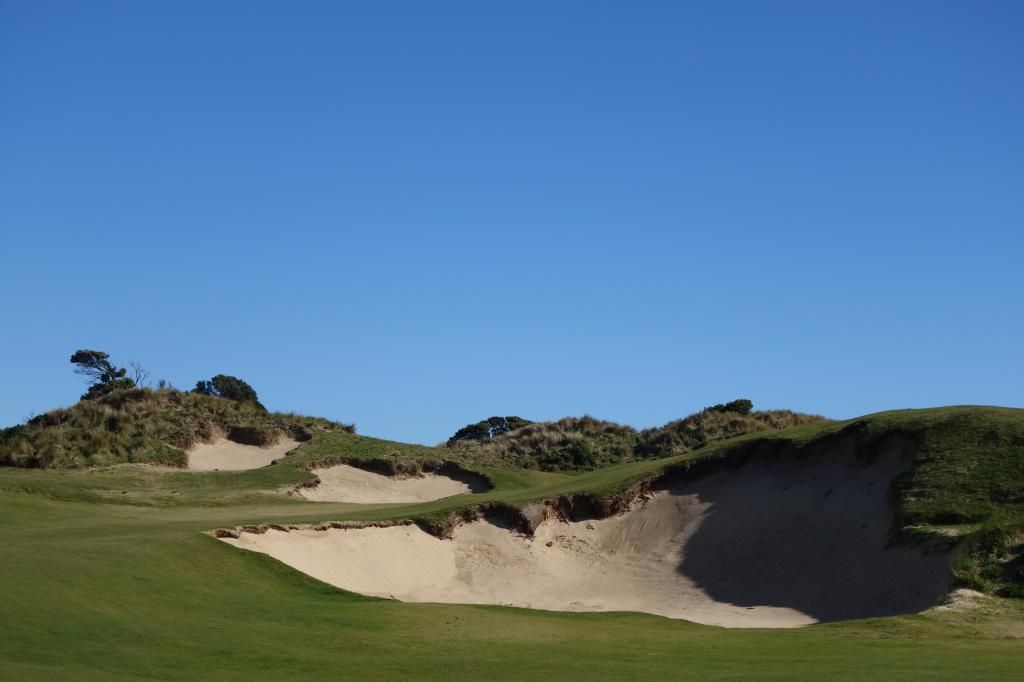
Five is a brilliant short par-3 with more epic views of the property, including the UFO-like Bauhausian lodge in the distance (that’s not a disparagement; I love the architecture of the lodge and think it fits the landscape perfectly). As on Red’s eighth, Blue’s fifth offers two teeing grounds, right and left, which offer totally different angles of attack—from the right tee, your tee shot is diagonal to the green and therefore presents less margin for error; from the left tee, your tee shot is straightaway to the green, so much so that one could actually putt it from the tee. The relative flatness of the front of the green gives way to a wildly undulating, and downward-sloping back of the green, which actually poses a greater problem for the golfer hitting down-the-green from the left tee. Carry it too far (or hit it too hard without adequate spin), and the ball will no doubt run off the back and toward the adjacent sixth tee. Left is dead, although it’s not quite as bad as the ridge-like falloff suggests. Bunkers on the other side of the ridge will catch at least some balls and allow for recovery shots, although good luck getting the ball to stop near the hole. The undulations and bunkers right are no bargain either, although you can use the slope behind the hole to your advantage.
Streamsong Blue, Hole 5 (left tee, straightaway angle to green)
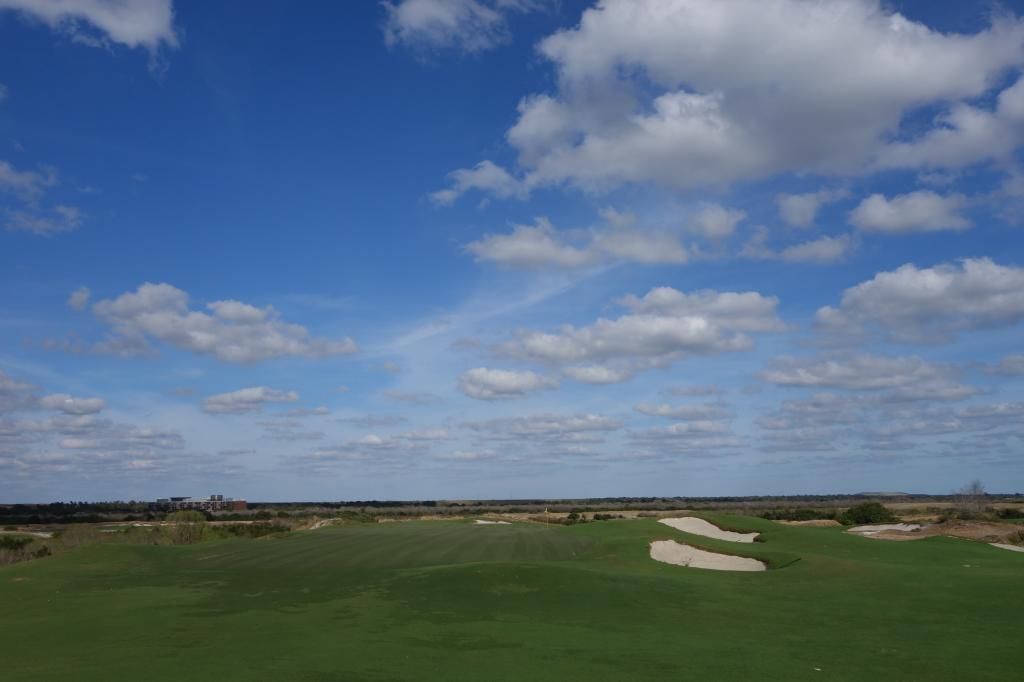
Visually, the sixth hole was candy to my eyes and unlike any hole I had ever seen. It's easy to see only the elliptical formation of fairway and fairway bunkers, gradually rising toward the fairway's left edge, and forget that there is actually a green in the distance off to the right. But there is. It's blind from most of the fairway, unless you hit a long ball to the high left side. The drive and the visuals from the tee reminded me of the drive on 17 Red, but there you're hitting downhill to the fairway, as opposed to gradually uphill from the tee on 6 Blue (which, unlike the also-short par-4 first, is potentially driveable, to boot). Once you get to the green, you're in for a treat, as its slopes will drive you mad, even if you approach them with only a wedge in your hand (as most will). I found that missing short left the easiest recovery/first putt. The large dune behind the green, which is part of the same dune formation that, farther on, contains the perched first tee, frames the hole beautifully.
Streamsong Blue, Hole 6 (tee)
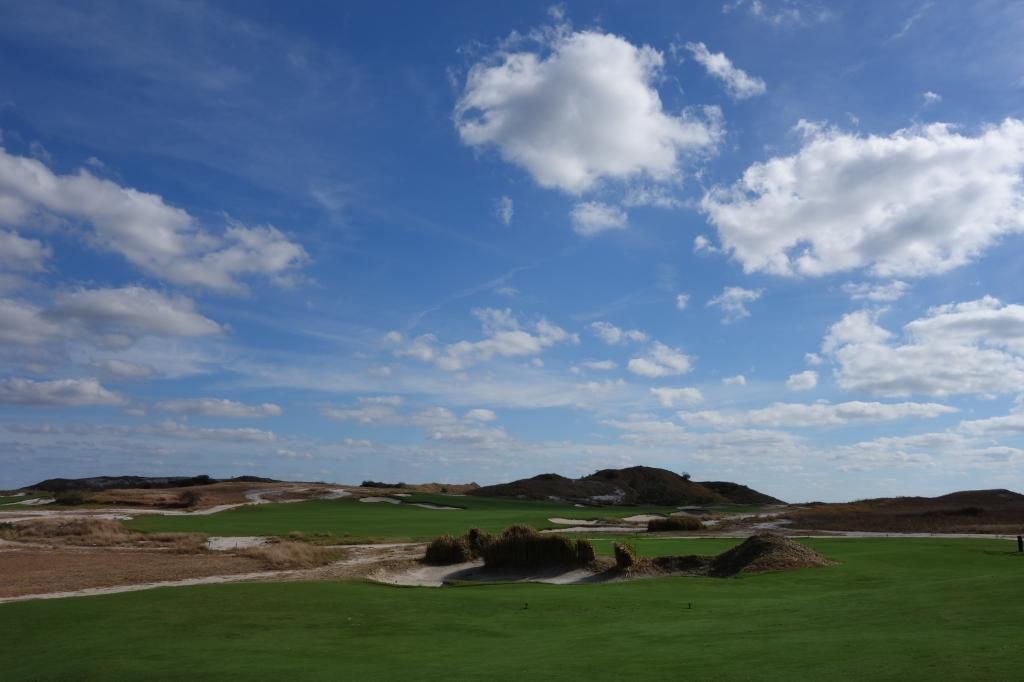
Streamsong Blue, Hole 6 (fairway)

Streamsong Blue, Hole 6 (green, with my girlfriend for a sense of scale)

The par-3 seventh is the most photographed hole on the entire property, so I won’t say too much about it. Again, it’s out of character and produces the one unfortunately long and convoluted green-to-tee walk on the Blue course (after putting out, you walk back over the bridge toward the front tees on the seventh, then up the steep hill to the right to get to 8 tee)—but it’s worth it. Of the two par-3s that use the same water hazard (Red 16 and Blue 7), I prefer Red 16. But 7 Blue, which is the shorter and more downhill of the two, is still a very fun hole to play—especially on walking to the tee for the first time (until you get there, you don't see it, as it's blind over the top of a ridge to the left of the sixth green). The falloffs on the left and right sides of the front of the green are pretty severe, but with a green that big and deep, you should be punished for flirting with the edges.
Streamsong Blue, Hole 7 (walk from 6 tee)
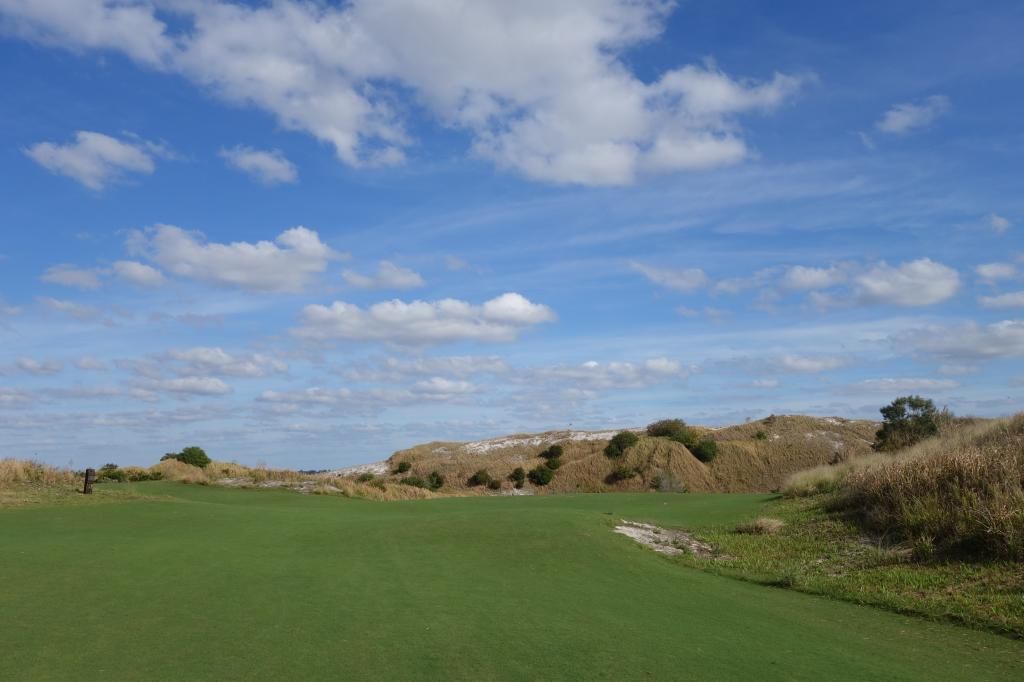
Streamsong Blue, Hole 7 (tee)
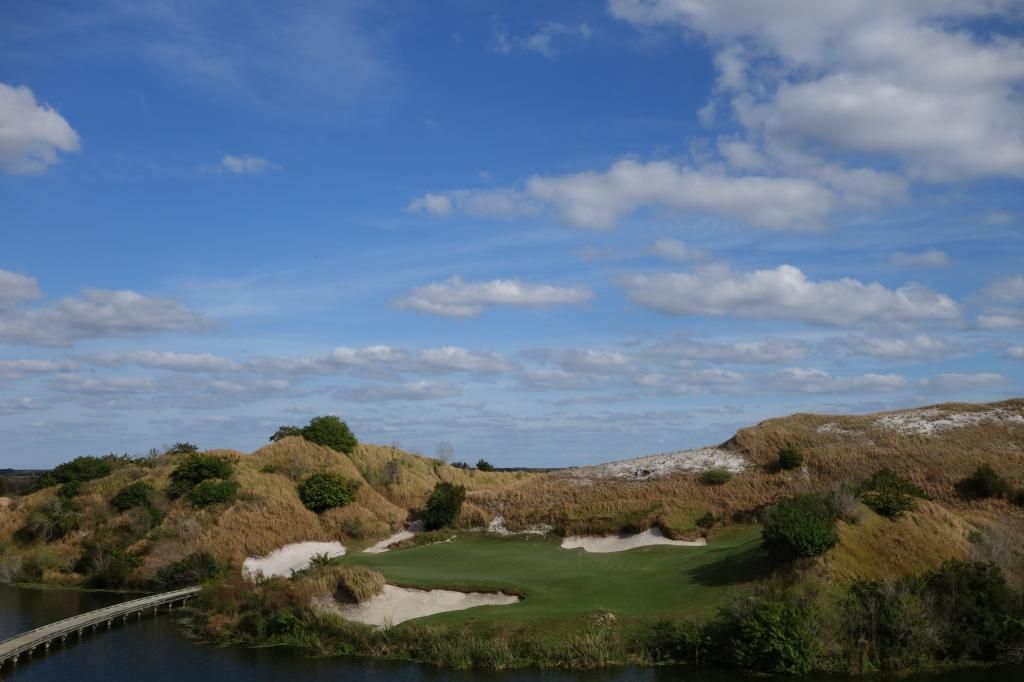
Streamsong Blue, Hole 7 (left side of green; note sharp falloff at edge)

Streamsong Blue, Hole 7 (from walking path to Hole 8, looking back toward the clubhouse)
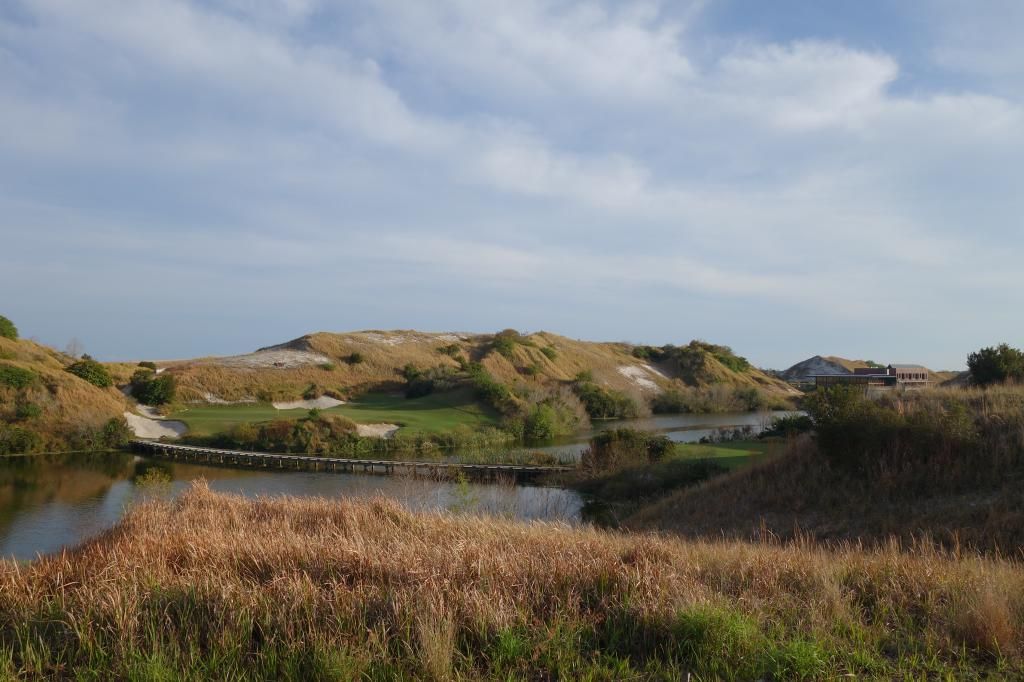
The eighth hole reminded me a lot of the third hole, albeit a longer version with a more straightaway tee shot. Because it’s longer than the third, it’s much harder. I hit five-iron (twice) and three-iron (once) for my approach shots, and although I hit great green-finding shots on two of those occasions, the shot isn’t easy. I imagine the hole gives many players fits. A small pond short left of the green doesn’t really come into play on the approach (it stops well short of the green), but it’s a well-placed visual distraction. And the falloff short right and bunkers long right make recoveries challenging.
Streamsong Blue, Hole 8 (fairway)
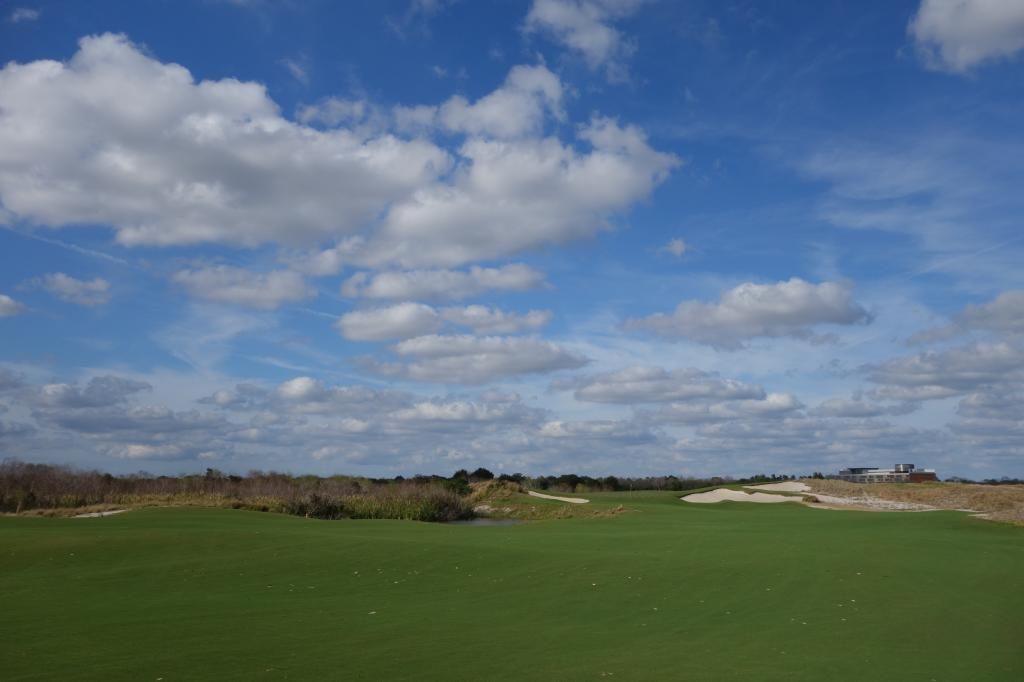
Streamsong Blue, Hole 8 (green)
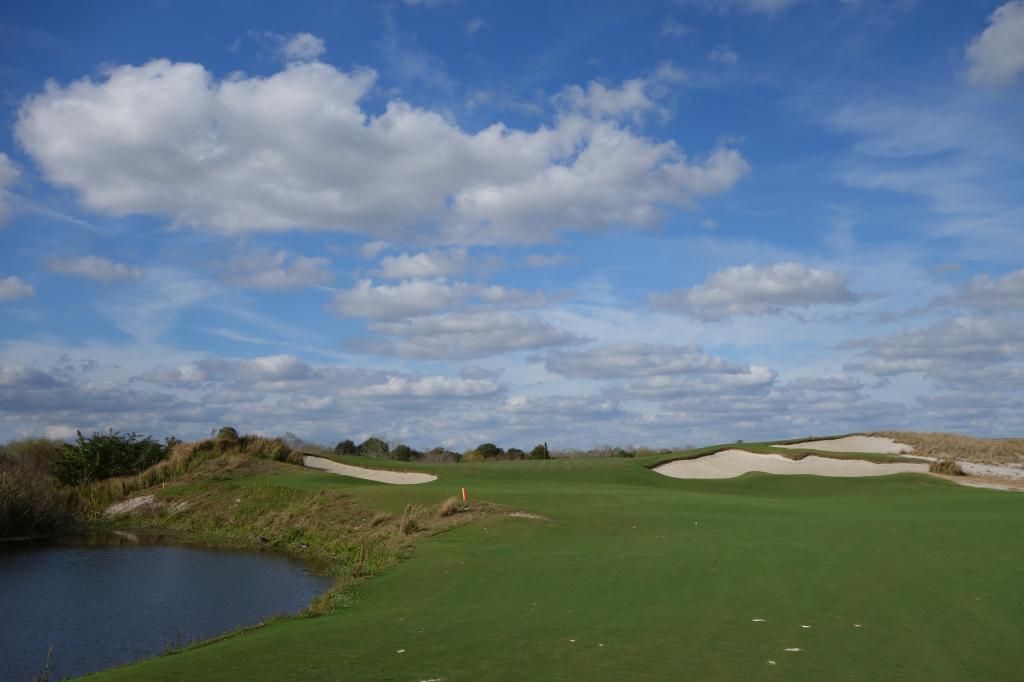
I loved the stretch from 9 to 12, which play along the same meadow-like, flattish piece of land (which I've already likened to the land comprising 10-12 on Bethpage Black, minus the huge fairway-separating bunkers). The tee shot on 9, framed by three beautifully layered bunkers on the right and open sky everywhere else, was my favorite on the course. Sure, it’s blind, but having played eight holes already (even if you haven’t done your research in advance), you should know that the fairway over the crest of the hill will be wide. Plus, it’s a par-5, so there’s no need to worry too much about missing it too far left. Given the shallow, wide green and the overall length of the hole, getting home in two is almost always out of the question—or at least not a good answer to it. I’m a long hitter (my three-wood, which I hit in lieu of my untrustworthy driver, goes 265 on average), and I hit three-wood, four-iron, and wedge all three rounds. If I were ever in a position to get close to the green in two, I would aim not for the green itself but instead for the front-right bunker. The green is elevated a bit, so it’s much easier to play up to the green from that bunker than down to the green from the back bunker, especially when the pin is on the right side of the green. All three shots on the hole are very pleasing on the eye—after the tee shot, the walk through the meadow-like fairway is incredibly serene and communal even (you see golfers coming up 11 Blue in the opposite direction to your left, and even a few off to the right on 17 Red), and the approach to the green is ethereal, as the green and bunkers seem to climb gradually up to the sky, which is very high at that point.
Streamsong Blue, Hole 9 (tee)
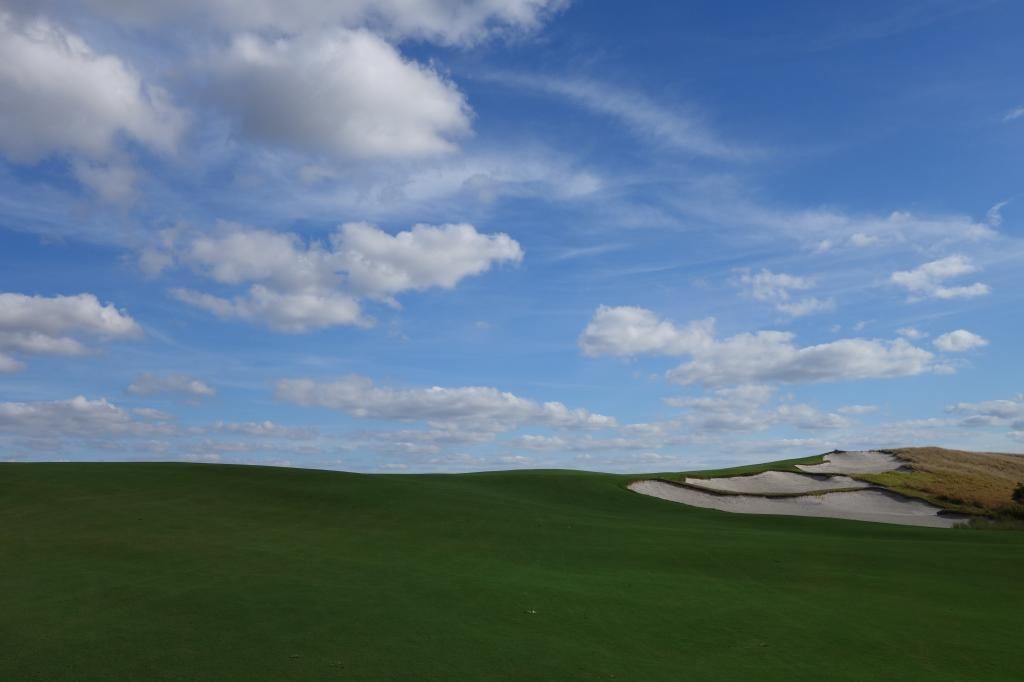
Streamsong Blue, Hole 9 (approach)
